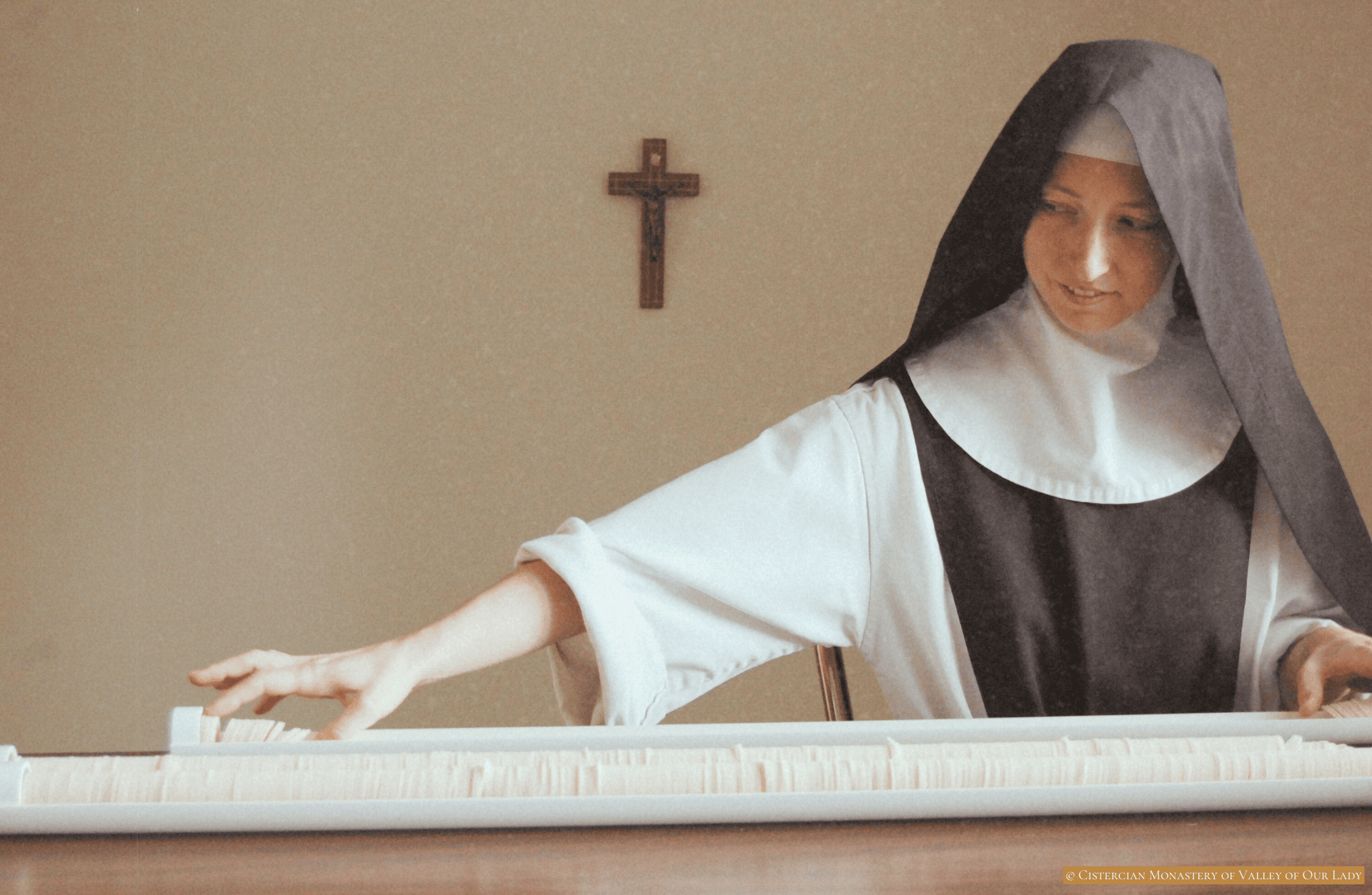A nun in formation at the Cistercian monastery of Valley of Our Lady reflects on her hidden life with Christ
Cistercian monastic contemplative life is hidden with Christ in God1, a life finding its source and summit in the liturgy2 with all things ordered to union with Jesus Christ, the Divine Bridegroom in praise of the Blessed Trinity. Inheriting the balance of ora et labora from our Holy Father St. Benedict and following our Cistercian Fathers in manual labour, we find expression of our union with the Eucharistic Christ in uniting our offering to His by making our own the work of human hands3 that is the bread, the matter for the Eucharistic species. The mystery of His Presence in the Eucharist is a paradox of proximity and hiddenness. Each stage of the production process becomes a possibility for union for the nuns; each work opens to its own prayer, particular to the heart of each nun wrapped in the silence of a heart immersed in the Word.
Weighing and Mixing
All the ways of a man are pure in his own eyes, but the Lord weighs the spirit.
Proverbs 16:2
Our flour comes to us from outside sources, yet adjacent fields remind us of the many images in scripture drawn from the grain of wheat which exemplify asceticism and purification of the heart. Heavier manual labour is conducive to working out the healing of memory necessary for interior silence. This first step of the altar bread process―weighing out hundreds of pounds of flour in preparation for baking―is an opportunity to dig deeply into the heart and lay bare areas in need of healing and conversion. Intercession comes to surface too as the flour sifts into containers.
The next step―mixing the water, wheat germ oil, and flour―requires a vigilance to ensure even mixing and correct viscosity that the batter, which is not unlike a runny pancake batter, may bake evenly without spot or wrinkle. The roar and gurgle of nearly twenty gallons mixing allow us to experience solidarity with the noise of world. The violence with which these three simple ingredients are blended in the mixer is not unlike the intensity sometimes experienced in the spiritual life4. The end result of a few minutes mixing is a smooth libation of fine flour poured out ready for baking.
Baking
Love’s flashes are flashes of fire, a most vehement flame.
Song of Songs 8:6

The wafer bakers are equipped with iron griddles similar to a waffle iron which imprint crosses or other designs reflecting what the bread will become. These rotate on a carousel before the nun baking who removes the rectangular sheets of wafer and prepares the plate for its next measure of batter which includes scraping any crumbs or residue and flooding it with water spray to produce an even bake. The warmth of the oven is a comforting heat in the Wisconsin winter and an added asceticism in the summer months. Each baked sheet of bread is checked for its worthiness to be used during the Holy Sacrifice. The rhythm of the work produces an interior silence with an openness to the Word allowing the Holy Spirit to bring His fire of transforming love.
Resting
Rest in the Lord and wait patiently for Him.
Ps 37:7
Beginning with the seventh day of creation until the Parousia, the Lord calls us continually to find our rest in Him. The bread too has its rest. It is stored away awaiting the next stage, hidden very much like ourselves. It is an important part of the process and continues through our own resting and rising.
Humidifying
Open to me, my sister, my love, my dove, my perfect one; for my head is wet with dew.
Song of Songs 5:2
After resting, the bread is must be softened by humidifying to allow it to cut without breaking. When one walks into the room where this takes place it is like walking into a warm cloud. A nun monitors the process to ensure the even quality. The Holy Spirit works in a similar way, first softening the heart to be docile and open to the voice of the Bridegroom.
Cutting and Sorting
Because there is one bread, we who are many are one body, for we all partake of the one bread.
1 Corinthians 10:17
This stage of the process is quite communal. While one sister cuts stacks of fifty sheets into the familiar round discs, the others sort out any bread with imperfections. Each side is checked for flaws. A steady rhythm can keep pace with decades of the rosary. It is work not unlike the basket-weaving tasks of the desert monks of old. Prayer, whether of direct intercession or focused on the Lord alone in adoration, contributes to the building up of the whole Body of Christ, which is the Church, as our lives become increasingly united to the Eucharistic Heart of Jesus.
Packing and Shipping
No speech, no word, no voice is heard yet their span extends through all the earth, their words to the utmost bounds of the world.
Psalm 19:3-4
Though we live a life of hiddenness and silence our packing and shipping office is a small reflection of the reach of our life. Most often, our life and its influence on the Church is hidden from ourselves. We live in the faith that our own prayer and self-offering united to that of Jesus’ is bearing fruit in ways that we will only know in eternity. It is enough to be given to Him, to offer our own fiat in Our Lady’s. The altar bread we bake is shipped both near and far. We serve parishes urban and rural, monasteries and missions. The universality of the reach, though limited, reflects in some way the reach of our prayers, when united to the infinite One is beyond our own understanding.
Article first published in Dowry No61, Spring 2024 (Pictures © author)

